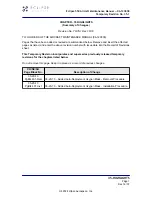
— 4 —
Because of the design of the nose catch for the bottom front wires on the Sport 2 it
is critically important that the nose line be attached properly during platform towing
operations. In no case should the nose line be attached in such a way that there is
any possibility that the nose line can pull forward on the nose wires, nose tang or
nose tang handle, or, in any other way, contribute to disengagement of the nose
wires. Please read the section on towing for more information.
Flight operation of the Sport 2 should be limited to non aerobatic maneuvers; those in which the pitch
angle will not exceed 30 degrees nose up or nose down from the horizon, and the bank angle will not
exceed 60 degrees. The Sport 2 is generally resistant to spinning, especially at VG settings of less than
50% (VG middle or looser). At VG settings greater than 50% (VGM to VG full tight), the Sport 2
becomes progressively more susceptible to spinning, though it is still characteristically resistant to
spinning. Any spin and / or the recovery from the spin may involve a possibility of a loss of control of
the glider, possibly including in flight inversion and possible structural failure.
Recovery from a spin requires unstalling of the wing, and it is therefore critically important that in the
event of a spin, no application of nose up pitch control be held. The Sport 2 will tend to recover from a
spin once control pressures are relaxed. To recover from a spin, move to the center of the control bar
and gently pull in to position the basetube below your shoulders. Do not pull in rapidly and do not
"stuff" the bar. As the nose lowers and the angle of attack is reduced, the stall will be broken and the
spin will stop. In an aggravated spin, be prepared for the nose to pitch down significantly, and for the
glider to accelerate to a high speed during the resulting dive. Ease the control bar out gently to recover
to level flight. Recognize that such recovery will consume significant altitude, and will result in the
glider assuming an unpredictable heading and attitude. Recovery from a spin at low altitude or in the
vicinity of terrain or other aircraft may involve a flight trajectory which intersects the terrain or
another aircraft at a high rate of speed. In view of the unpredictable nature of spins and spin recovery,
Wills Wing recommends that no attempt should ever be made to deliberately spin the glider. The Sport
2 provides the pilot with a high degree of pitch authority, in combination with a very low twist sail. As a
result, it is possible to produce a very aggravated and severe stall, the recovery from which may
involve very severe pitch down rotation, the pilot going weightless, and the glider recovering via an
unpredictable trajectory with a significant altitude loss. Therefore, aggravated stalls should not be
induced except on landing flare.
The maximum steady state speed for a prone pilot in the recommended weight range full forward on
the control bar with the VG set full tight will range from approximately 47 m.p.h. to as high as 53 mph
or more for the Sport 2, depending on wing loading, harness design and adjustment, and glider tuning.
The placarded speed never to exceed for the Sport 2 is 53 m.p.h. The Vne speed will generally be
achieved, if achievable in steady state wings level flight, for a prone pilot with the control bar at full
arms extension. The placarded maximum speed for maneuvering flight or flight in rough air is 46 mph.
This speed will be achieved for a prone pilot with the control bar basetube approximately four to eight
inches below the waist. This speed should not be exceeded in anything other than smooth air. No
abrupt maneuvering or control inputs should be made at anything above this speed. The stall speed of
the Sport 2 at maximum recommended wing loading is 25 m.p.h. or less. The top (steady state) speed
at minimum recommended wing loading for a prone pilot with a properly designed and adjusted
harness is at least 35 m.p.h.. All speeds given above are indicated airspeeds, for a properly calibrated
airspeed indicator mounted in the vicinity of the pilot. An airspeed indicator marked with the appropri-
ate speed ranges is available for the Sport 2 and it is recommended that the pilot fly with this or some
Summary of Contents for Sport 2 155
Page 1: ...Sport 2 155 Owner Service Manual June 1st 2004 First Edition...
Page 2: ......
Page 6: ......




































